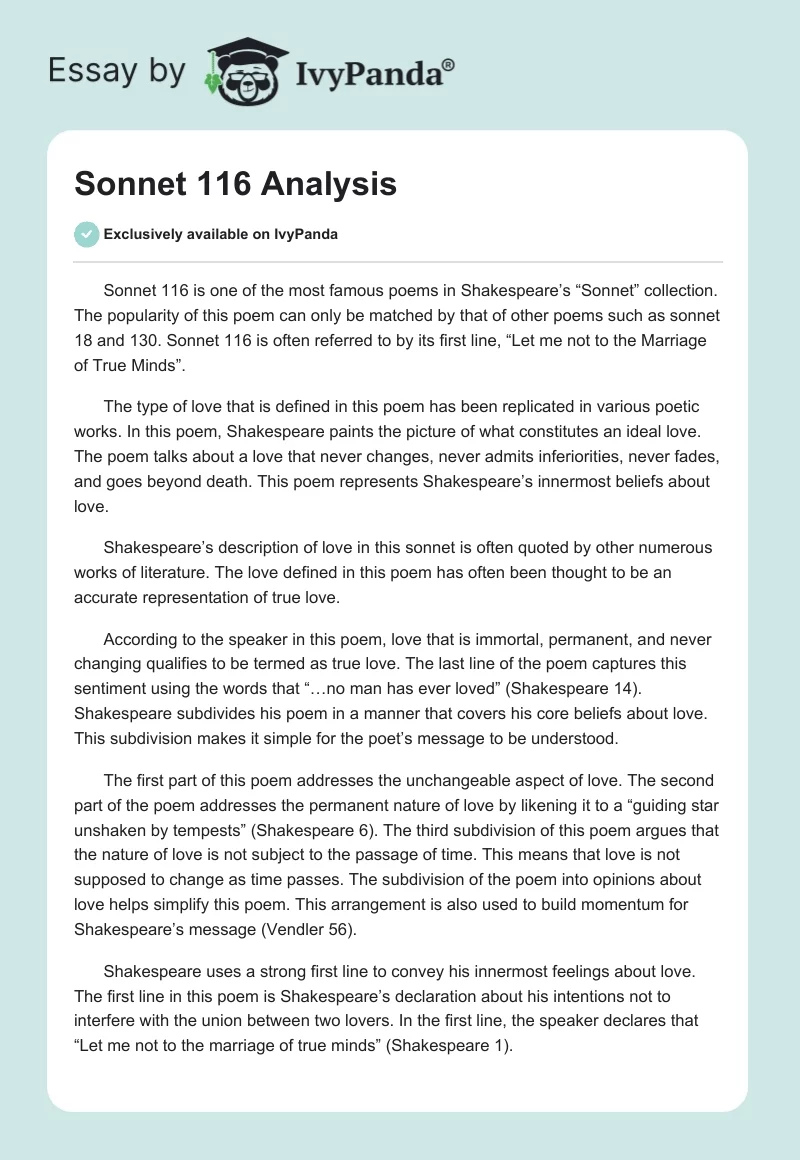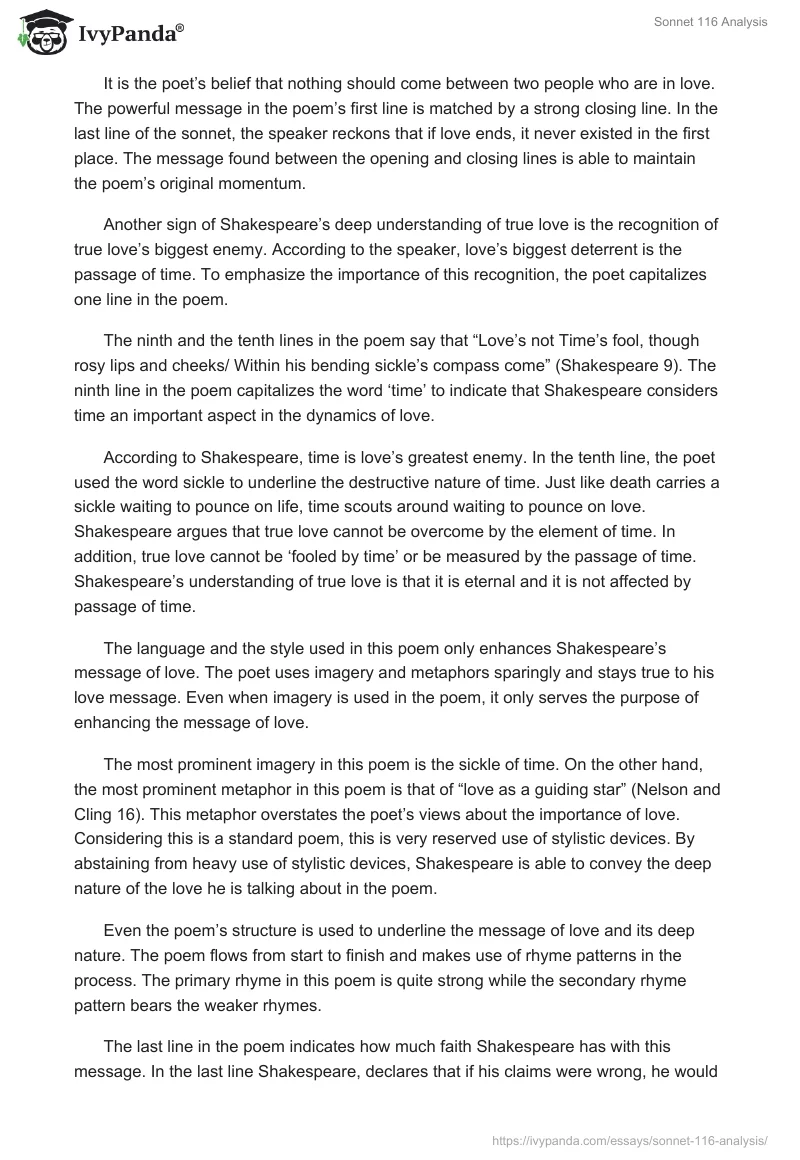Sonnet 116 is one of the most famous poems in Shakespeare’s “Sonnet” collection. The popularity of this poem can only be matched by that of other poems such as sonnet 18 and 130. Sonnet 116 is often referred to by its first line, “Let me not to the Marriage of True Minds”.
The type of love that is defined in this poem has been replicated in various poetic works. In this poem, Shakespeare paints the picture of what constitutes an ideal love. The poem talks about a love that never changes, never admits inferiorities, never fades, and goes beyond death. This poem represents Shakespeare’s innermost beliefs about love.
Shakespeare’s description of love in this sonnet is often quoted by other numerous works of literature. The love defined in this poem has often been thought to be an accurate representation of true love.
According to the speaker in this poem, love that is immortal, permanent, and never changing qualifies to be termed as true love. The last line of the poem captures this sentiment using the words that “…no man has ever loved” (Shakespeare 14). Shakespeare subdivides his poem in a manner that covers his core beliefs about love. This subdivision makes it simple for the poet’s message to be understood.
The first part of this poem addresses the unchangeable aspect of love. The second part of the poem addresses the permanent nature of love by likening it to a “guiding star unshaken by tempests” (Shakespeare 6). The third subdivision of this poem argues that the nature of love is not subject to the passage of time. This means that love is not supposed to change as time passes. The subdivision of the poem into opinions about love helps simplify this poem. This arrangement is also used to build momentum for Shakespeare’s message (Vendler 56).
Shakespeare uses a strong first line to convey his innermost feelings about love. The first line in this poem is Shakespeare’s declaration about his intentions not to interfere with the union between two lovers. In the first line, the speaker declares that “Let me not to the marriage of true minds” (Shakespeare 1).
It is the poet’s belief that nothing should come between two people who are in love. The powerful message in the poem’s first line is matched by a strong closing line. In the last line of the sonnet, the speaker reckons that if love ends, it never existed in the first place. The message found between the opening and closing lines is able to maintain the poem’s original momentum.
Another sign of Shakespeare’s deep understanding of true love is the recognition of true love’s biggest enemy. According to the speaker, love’s biggest deterrent is the passage of time. To emphasize the importance of this recognition, the poet capitalizes one line in the poem.
The ninth and the tenth lines in the poem say that “Love’s not Time’s fool, though rosy lips and cheeks/ Within his bending sickle’s compass come” (Shakespeare 9). The ninth line in the poem capitalizes the word ‘time’ to indicate that Shakespeare considers time an important aspect in the dynamics of love.
According to Shakespeare, time is love’s greatest enemy. In the tenth line, the poet used the word sickle to underline the destructive nature of time. Just like death carries a sickle waiting to pounce on life, time scouts around waiting to pounce on love. Shakespeare argues that true love cannot be overcome by the element of time. In addition, true love cannot be ‘fooled by time’ or be measured by the passage of time. Shakespeare’s understanding of true love is that it is eternal and it is not affected by passage of time.
The language and the style used in this poem only enhances Shakespeare’s message of love. The poet uses imagery and metaphors sparingly and stays true to his love message. Even when imagery is used in the poem, it only serves the purpose of enhancing the message of love.
The most prominent imagery in this poem is the sickle of time. On the other hand, the most prominent metaphor in this poem is that of “love as a guiding star” (Nelson and Cling 16). This metaphor overstates the poet’s views about the importance of love. Considering this is a standard poem, this is very reserved use of stylistic devices. By abstaining from heavy use of stylistic devices, Shakespeare is able to convey the deep nature of the love he is talking about in the poem.
Even the poem’s structure is used to underline the message of love and its deep nature. The poem flows from start to finish and makes use of rhyme patterns in the process. The primary rhyme in this poem is quite strong while the secondary rhyme pattern bears the weaker rhymes.
The last line in the poem indicates how much faith Shakespeare has with this message. In the last line Shakespeare, declares that if his claims were wrong, he would refrain from writing. Moreover, Shakespeare declares that if this message is wrong all his other messages are also wrong.
Works Cited
Nelson, Jeffrey and Andrew Cling. “Love’s Logic Lost: The Couplet of Shakespeare’s Sonnet 116.” Quarterly Journal of Short Articles, Notes and Reviews 13.3 (2000): 14-19. Print.
Shakespeare, William. Shakespeare’s Sonnets, London, United Kingdom: Oxford UP, 1936. Print.
Vendler, Helen. The Art of Shakespeare’s Sonnets, New York, NY: Harvard University Press, 2007. Print.

 4.00
4.00
